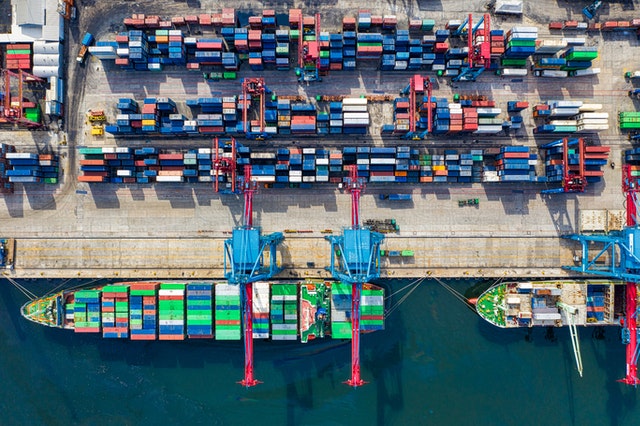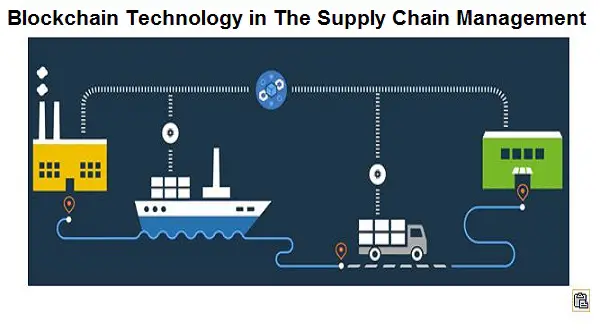If you know the financial market, you’ve probably heard of blockchain. This term is used to record transactions and entries in so-called financial accounting. The relationship of the blockchain in supply chain is what you may not know. It may seem strange at first, but this technological innovation tends to make operations easier and more confident. After all, activities will be more secure and your company will achieve more direct communication with customers and suppliers.
From now on, you will understand how this technology works, how it can relate to the supply chain, and how this issue can revolutionize logistics and purchasing management. So, let’s go there?
The Blockchain Concept
This word can also be understood as a protocol of trust because its objective is to decentralize information to increase its protection. It’s a data structure also made up of records that are distributed and shared. The objective is to generate a global list of the operations executed in a certain market. Blockchain technology was first used in the financial sector mainly due to the advent of bitcoins, virtual currencies adopted in some electronic transactions.
However, this tool is increasingly adopted by other sectors. This is because the technology can be compared to a ledger, that is, it represents an accounting entry or record of an operation performed. The difference is that transactions are public, universal, and shared through infrastructure or deployment.
This Innovation Was Also Created From a Tripod:
- Encryption for data security.
- Game theory, which aids in strategic decision-making.
- Peer-to-peer (P2P) networks, which are connected without central coordination.
In addition, transactions have digital signatures that ensure their authenticity and prevent possible tampering. Realize that the idea of the blockchain is to have complete blocks of information, which are updated by new sets of records. The addition is done chronologically and linearly and creates a node. Each one of them is connected to the network and has the objective of transmitting and validating the operations.
Thus, a copy of the structure is made each time an entry is made to this network. One advantage is that the information you enter is protected by encryption and you do not need to have a central authority. Data that is entered cannot be altered or deleted. The result is more confidence in the communication between the parties. The relationship also takes place directly, which means that there are no third parties. It is, therefore, a paradigm shift, especially concerning the monitoring of transactions and payment methods.
If cloud computing currently leads by having a centralized storage system, the new technology does the opposite, because it decentralizes information. This feature is a benefit because it improves security and decreases reliance on a third-party service. After all, data is stored and automatically distributed across multiple locations and computers. Therefore, experts indicate that there should be 300 times more space available on hard drives compared to the current model, based on cloud computing.
In this context, it is worth remembering that, despite decentralization being positive, there are already companies creating their platforms, fully adapted for the supply chain management. Among the best-known systems are Microsoft and IBM, but some startups are also betting on this idea.
Because? The answer is simple. This is also seen as one of the main innovations in the financial market and supply chain management.
After all, it revolutionizes these sectors for all the benefits it brings, as we will see better below.
Blockchain Relationship With the Supply Chain
The supply chain is the logistical cycle, which comprises several stages, according to the product that is inserted in this chain. Due to its scope (ranging from the supplier to the final consumer), it refers to a system of people, organizations, activities, resources, and information. As the inefficiency of the supply chain impacts the organizational reputation and image, as well as customer satisfaction, it is necessary to seek alternatives to ensure the best possible performance.
After all, common problems found in this cycle are high costs, poor process agility, and low product quality. That’s where the blockchain comes in. Although not specifically related to the transport and distribution of goods, this technology works to facilitate accounting records throughout the supply chain.
The result is a platform capable of monitoring all stages and processes, which allows increasing the value of the flow of products in the chain. It should also be noted that the use of this tool in the supply chain is still in its infancy.
However, experts highlight the fact that its characteristics are suitable for monitoring and recording a high volume of data – exactly what happens in the case of logistics.
As a result, the technology brings more efficiency to short-term lending or controlling the movement of parts throughout the entire aviation supply chain, for example.
It is also worth thinking about small and medium-sized companies, which can check at which stage a certain input is. At the same time, there are benefits for consumers, who demand more transparency from companies.
Due to these more recent requirements – arising from the advent of the internet and social networks – an informational stream is established that is supplied by the new tool.
For example: when applied by the supply chain, the technology makes it possible to track the product from its input to delivery to the final consumer.
In practice, the customer will be able to find out, for example, if the item was manufactured with slave labor, if it includes good sustainability practices if it contains chemical products in its formulation, and so on.
One company that is already using this practice for its supply chain is Toyota Motors. The justification is the fact that, after the financial market, the supply chain is the most likely application for this technology – which is why your company cannot be left out.
Another reason is that the European Union has been demanding that companies provide additional information for their products and services. Thus, it is necessary to review the processes so that they become more transparent and competitive. Otherwise, the company could lose market share.
Possible Uses of this Technology in the Supply Chain


In addition to Toyota, other large companies are already using blockchain tools to manage the supply chain. Among them are Walmart, Nestlé, and IBM.
Initially, they adopted the technology to monitor food products from mango and pork suppliers.
The tracking was done using the following criteria:
- lot number;
- item origin detail;
- expiration date;
- Factory data and processing.
This information was entered into the system and indicates points that present, for example, problems related to food safety. Another possibility in the consumer industry is focused on the area of global shipping and trade.
In this case, the tool can be adopted for digitizing and sharing documents, such as customs and letters of credit. As a result, payment to suppliers is faster. It is evident, then, that this tool improves the efficiency and transparency of processes. Managers and entrepreneurs can implement improvements to their operations and, consequently, start to compete with disruptive organizations that bet on innovation.
The Reasons That Justify The Adoption Of The Blockchain For The Supply Chain
The corporate world is formed by partnerships and contract signatures, which form a true network of influences and availability of services. This means that your company depends on suppliers and vice versa. This common scenario, which we are all used to, presents a problem: it is very easy to adopt behaviors and irregular histories or that go against the mission, vision, and values defined by your organization. These situations, however, are not traceable. Even so, they can negatively impact your business. With the idea of the trust protocol, this context is changed.
This technology validates and exposes all the stages that make up the logistics, recording any problems that occur along the way. This information cannot be modified or deleted, which increases security. Due to encryption, changes can only be performed by a hacker. It is still virtually impossible because it would be necessary to break the encryption of all network blocks on all computers at the same time. It is a culture change, which demonstrates the power of decentralized networks and indicates a change in the behavior of purchasing and logistics managers.
The Advantages Of Adopting The Tool For The Supply Chain
The main benefits arising from this decision are:
Extended Control
The blockchain technology in supply chain management, allows recording different data, such as price, location, date, certification, quality, and any other that is relevant to supply chain management.
Availability of information:
- increases product tracking.
- decreases counterfeiting and black market losses.
- raises the visibility and compliance of third-party manufacturing contracts.
- tends to improve organizational positioning with customers and suppliers.
Increased Transparency
The information recorded in the blockchain cannot be modified and becomes visible to everyone involved. It also becomes possible to analyze all stages of the supply chain and identify details about certain items. This characteristic tends to improve the relationship with suppliers, who will be more aligned with internal processes. It even better positions the company about the target audience, which tends to improve its organizational reputation and image.
Risk And Cost Reduction
Your business benefits from the in-depth monitoring enabled by the blockchain. As it is possible to control all stages, it is more difficult to have losses along the way – especially for perishable products – and you can still have a clearer view of the entire process, which allows you to create better strategies.
The Challenges To Be Overcome
The implementation of the new technology applied to the supply chain requires some changes in behavior. The first is that leaders and managers need to learn to share information, including information that is currently treated as confidential.
After all, despite being safe, the idea of the tool is precise to record all information.
Another hurdle to overcome is issues relating to global governance. Realize that there are free and closed protocols and this situation requires standards and agreements that ensure the compatibility of the existing blocks in the chain. This issue involves maritime laws, regulations, and commercial codes that regulate the ownership of goods and property rights.
However, this task is somewhat complex as the blockchain is dematerialized, denationalized, and automated.
It is also worth remembering that companies face many challenges in their supply chains.
These include a lack of transparency due to inconsistent or unavailable data, heavy manual work, lack of interoperability, and limited information about the product’s lifecycle and shipping history. Given this scenario, the blockchain can contain these inefficiencies and still add more value to the executed processes.
More than an Electronic Data Interchange (EDI), the blockchain offers differentiated advantages in infrastructure and analytical capabilities.
Despite this, it is expected that the blockchain will be implemented in the supply chains of most companies in the world in a few years.
Therefore, it is important to be careful not to lose this trend.
Blockchain Integration In The Supply Chain
The blockchain can store any information, such as purchase prices, supplier identity, negotiation histories, and contracts. This data is encrypted and can be protected from unauthorized access.
3 steps lead to the successful use of this tool in the supply chain. Are they:
- configure the blockchain used by the company so that the company has time to get used to this technology while ensuring data consistency and availability.
- expand the tool to partners, such as direct and third-party logistics providers, which promotes data exchange.
- integrate everyone involved along the supply chain to the new tool, including end consumers.
However, it is essential to analyze the relationship of this technology with e-procurement.
The tool meets the needs of users of electronic procurement platforms.
In addition, the transparency offered by the blockchain brings stronger negotiations and improves the relationship with suppliers. To better understand the advantages of the integration between e-procurement and the blockchain, note that this technology has a centralized, shared, and secure data storage, while other systems use multiple databases that hinder efficiency, access to functionalities, and the sharing itself.
Thus, the new technology makes it possible to improve transparency and the processes carried out in the supply chain. Your business can benefit in different ways, but they all lead to increased competitive advantage and greater efficiency at every stage of the supply chain.


I am Yokesh Shankar. Co-Founder of BlockchainX, My vision and time to offer the best products for our clients without apprehensions at economic rates. Making virtual dreams a reality, My interest in Blockchain technology and crypto started when I was an undergrad. It has since then transformed into something much bigger for me. I believe that Blockchain is undoubtedly the future of technology as we know it, and have been trying to share as much knowledge as I humanly can with people. From analyzing and assessing the clients’ requirements in detail to proffering the best Blockchain and Crypto Consultant.
Subscribe to our newsletter
The basic goal of “The Business Goals” is to help the entrepreneurs’ community in achieving their goals and business objectives by providing the authentic and latest entrepreneurial ideas.
















































Amazing blog related blockchain….